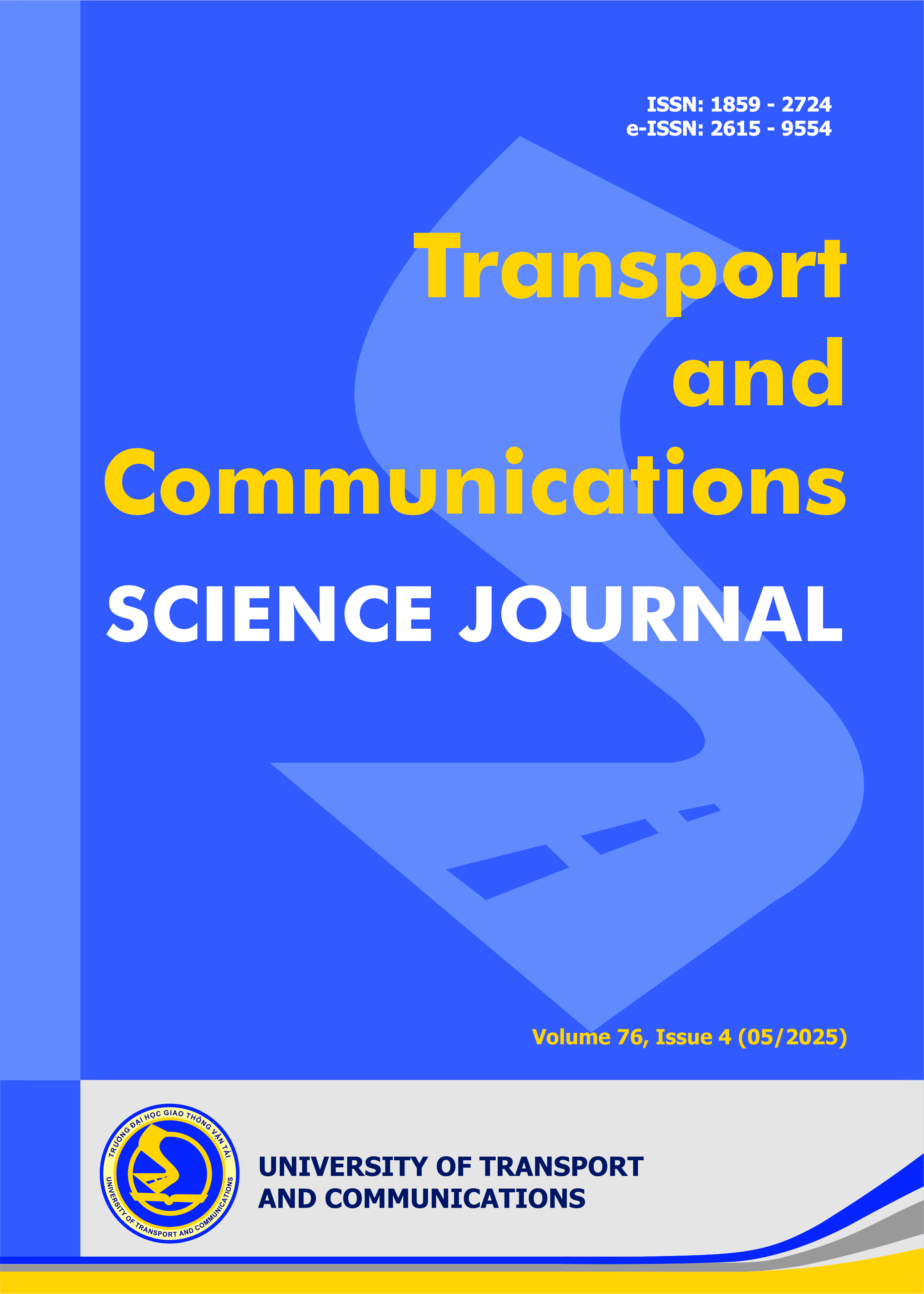Effect of asphalt-to-cement ratio on strength of cement asphalt mortar used in high-speed railway
Email:
nguyenngoclan@utc.edu.vn
Tóm tắt
The ballastless track structure (slab track) structure is commonly used in high-speed railway construction today. For this type of railway structure, the cement asphalt mortar polymer (CAM) layer plays an important role in damping, creating smoothness, reducing noise and ensuring simultaneous operation of the structure. Therefore, the CAM layer needs to be designed and manufactured to ensure ease of construction, strength and integrity for the entire slab track structure. This paper presents the initial experimental research results on the technology of CAM layer materials. The experimental studies were evaluated based on mixtures with asphalt/cement (A/C) ratios varying from 0.3, 0.4, 0.5, 0.6, and 0.7, respectively. The results of the research showed that, when the ratio of A/C increased, the flow time, flexural strength and compressive strength decreased. This trend of results was also completely consistent with the results of microstructural analysis by scanning electron microscope of mortar samples at 7 days of ageTài liệu tham khảo
[1]. C. Esveld, Slab track: A competitive solution, Rail Int., 6 (1999) 32–46.
[2]. Y. Koyama, Railway construction in Japan, Jap. Railw. Transp. Rev., 32 (1997) 36–41 (in Japanese).
[3]. S.Miura, H. Takai, M. Uchida, Y. Fukada, The mechanism of railway tracks, Jap. Railw. Transp. Rev., 3 (1998) 38–45.
[4]. C. Esveld, Recent development in slab track, Euro. Railw. Rev.,2 (2003) 81–85.
[5]. F. Z. Wang, Z. C. Liu, T. Wang, S. G. Hu, A novel method to evaluate the setting process of cement and asphalt emulsion in CA mortar, Mater. Struct., 41 (2008) 643–647.
[6]. J. Wang, Y. Zhou, T. Wu, X. Wu, Performance of Cement Asphalt Mortar in Ballastless Slab Track over High-Speed Railway under Extreme Climate Conditions. International Journal of Geomechanics, 19 (2019) 04019037.
[7]. S. Hu, G., T. Wang, F. Z. Wang, and Z. C. Liu, Adsorption behaviour between cement and asphalt emulsion in cement-asphalt mortar, Adv. Cem. Res, 21 (2020) 11–14.
[8]. O.Kazuyosi, I.Yosio, Compressive strength of the CA mortar and its temperature susceptiblity, Mem. Fac. Technol., Koyhama Univ., 10 (1976) 1–13 (in Japanese).
[9]. S. H.Jin, X. F.Chen, J. Yang, Key technologies of CA mortar for slab track, China Railw. Sci., 27 (2006) 20–24 (in Chinese).
[10]. Asphalt Institute, Basic Asphalt Emulsion Manual, MS-19.
[11]. D. T. Zhao, T. C. Wang, X. Y. Liu, Configuration and performance of CA mortar for ballastless slab track, J. Tianjing. Univ., 41 (2008) 793–779 (in Chinese).
[12]. J. Q. Zuo, Q. B.Jiang, B. F.Cai, Experimental study on emulsified asphalt for CA mortar used in slab track, Rail. Constr. Technol., 2 (2005) 68–70 (in Chinese).
[13]. J. Q. Zuo, Q. B. Jiang, D. Z.Fu, Research of cement asphalt mortar elastic cushion for slab track, Railw. Eng., 9 (2005) 96–98 (in Chinese).
[14]. Y. L. Liu, X.M. Kong, Y.Zou, P. Y. Yan, Static and dynamic mechanical behavior of cement asphalt mortars, Chin. Railw. Eng., 6 (2009) 1–7 (in Chinese).
[15]. L.Ferrara, M. Cremonesi, N. Tregger, On the identification of rheological properties of cement suspensions: Rheometry, computa tional fluid dynamics modeling and field test measurements, Cem. Concr. Res, 42 (2012) 1134–1146. https://doi.org/10.1016/j.cemconres
[16]. Q.Wang, P.Y. Yan, R.H. A, J.B. Yang, X.M. Kong, Strength mechanism of cement-asphalt mortar, J. Mater. Civ. Eng, 23 (2011) 135–1359.
[17]. Y.Q. Tan, J. Ouyang, J.F. Lv, Y.L. Li, Effect of emulsifier on cement hydration in cement asphalt mortar, Constr. Build. Mater, 47 (2013) 159–164.
[2]. Y. Koyama, Railway construction in Japan, Jap. Railw. Transp. Rev., 32 (1997) 36–41 (in Japanese).
[3]. S.Miura, H. Takai, M. Uchida, Y. Fukada, The mechanism of railway tracks, Jap. Railw. Transp. Rev., 3 (1998) 38–45.
[4]. C. Esveld, Recent development in slab track, Euro. Railw. Rev.,2 (2003) 81–85.
[5]. F. Z. Wang, Z. C. Liu, T. Wang, S. G. Hu, A novel method to evaluate the setting process of cement and asphalt emulsion in CA mortar, Mater. Struct., 41 (2008) 643–647.
[6]. J. Wang, Y. Zhou, T. Wu, X. Wu, Performance of Cement Asphalt Mortar in Ballastless Slab Track over High-Speed Railway under Extreme Climate Conditions. International Journal of Geomechanics, 19 (2019) 04019037.
[7]. S. Hu, G., T. Wang, F. Z. Wang, and Z. C. Liu, Adsorption behaviour between cement and asphalt emulsion in cement-asphalt mortar, Adv. Cem. Res, 21 (2020) 11–14.
[8]. O.Kazuyosi, I.Yosio, Compressive strength of the CA mortar and its temperature susceptiblity, Mem. Fac. Technol., Koyhama Univ., 10 (1976) 1–13 (in Japanese).
[9]. S. H.Jin, X. F.Chen, J. Yang, Key technologies of CA mortar for slab track, China Railw. Sci., 27 (2006) 20–24 (in Chinese).
[10]. Asphalt Institute, Basic Asphalt Emulsion Manual, MS-19.
[11]. D. T. Zhao, T. C. Wang, X. Y. Liu, Configuration and performance of CA mortar for ballastless slab track, J. Tianjing. Univ., 41 (2008) 793–779 (in Chinese).
[12]. J. Q. Zuo, Q. B.Jiang, B. F.Cai, Experimental study on emulsified asphalt for CA mortar used in slab track, Rail. Constr. Technol., 2 (2005) 68–70 (in Chinese).
[13]. J. Q. Zuo, Q. B. Jiang, D. Z.Fu, Research of cement asphalt mortar elastic cushion for slab track, Railw. Eng., 9 (2005) 96–98 (in Chinese).
[14]. Y. L. Liu, X.M. Kong, Y.Zou, P. Y. Yan, Static and dynamic mechanical behavior of cement asphalt mortars, Chin. Railw. Eng., 6 (2009) 1–7 (in Chinese).
[15]. L.Ferrara, M. Cremonesi, N. Tregger, On the identification of rheological properties of cement suspensions: Rheometry, computa tional fluid dynamics modeling and field test measurements, Cem. Concr. Res, 42 (2012) 1134–1146. https://doi.org/10.1016/j.cemconres
[16]. Q.Wang, P.Y. Yan, R.H. A, J.B. Yang, X.M. Kong, Strength mechanism of cement-asphalt mortar, J. Mater. Civ. Eng, 23 (2011) 135–1359.
[17]. Y.Q. Tan, J. Ouyang, J.F. Lv, Y.L. Li, Effect of emulsifier on cement hydration in cement asphalt mortar, Constr. Build. Mater, 47 (2013) 159–164.
Tải xuống
Chưa có dữ liệu thống kê

Nhận bài
02/04/2025
Nhận bài sửa
03/05/2025
Chấp nhận đăng
09/05/2025
Xuất bản
15/05/2025
Chuyên mục
Công trình khoa học
Kiểu trích dẫn
Nguyen Van, H., Ngoc Lan, N., Pham Thi Thanh, T., & Nguyen Bao, L. (1747242000). Effect of asphalt-to-cement ratio on strength of cement asphalt mortar used in high-speed railway . Tạp Chí Khoa Học Giao Thông Vận Tải, 76(4), 597-609. https://doi.org/10.47869/tcsj.76.4.12
Số lần xem tóm tắt
69
Số lần xem bài báo
57









